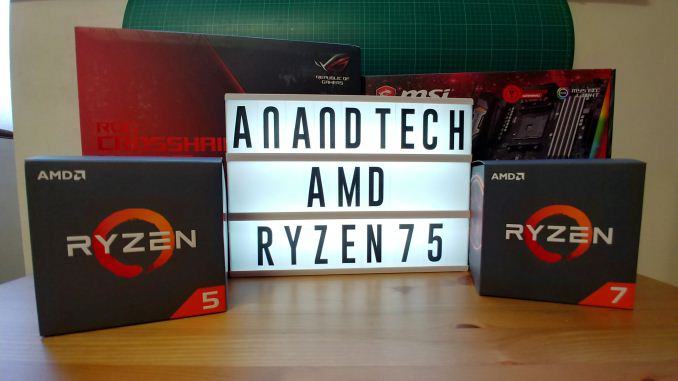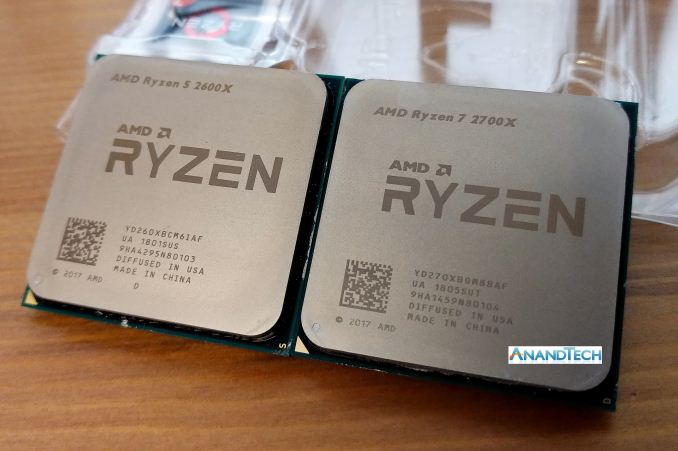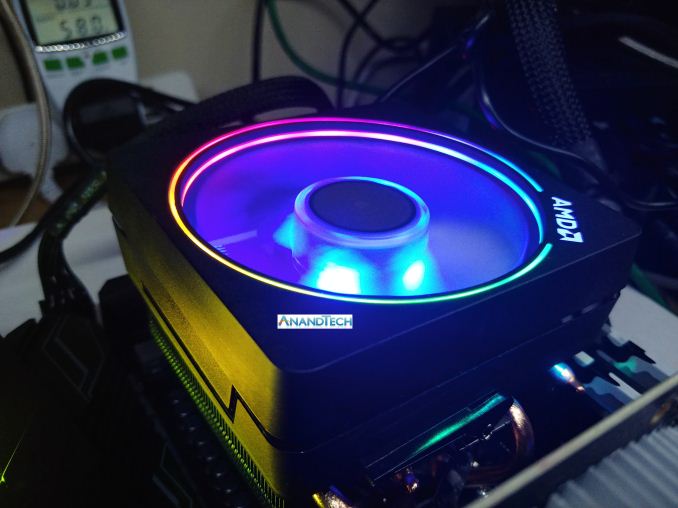The AMD 2nd Gen Ryzen Deep Dive: The 2700X, 2700, 2600X, and 2600 Tested
by Ian Cutress on April 19, 2018 9:00 AM EST
With 2017 finished, and Ryzen being very successful for AMD, the inevitable question was due: what happens next? Early in 2018, the plans were laid bare: a second generation Ryzen processor was set to come in mid-year, followed by a second generation Threadripper, using GlobalFoundries’ 12nm process. This is not AMD’s next big microarchitecture, which we know is called Zen 2 on 7nm, but an opportunity to launch a wave of components with minor improvements and take advantage of a manufacturing process that gives more frequency and more performance. Today AMD is launching four CPUs, and we have tested them all.
Updates
- (4/21) Some of our results, initially thought due to Spectre/Meltdown patches, were not in line with others. Testing audit was started.
- (4/25) Our extensive internal audit showed reasons for the differences, as documented in detail in this follow-up article. In short, an issue with a non-standard use timers on Windows was causing the performance of both AMD and Intel processors to dip, particularly impacting the latter.
- (5/2) Benchmark results have been updated.
- (5/22) X470 Motherboard. StoreMI, and Power Analysis pages updated.
- (5/26) Conclusion Updated, Performance Per Dollar graphs added.
Straight To The Scene: The New CPUs
For readers that only want one piece of information, this is it: AMD is launching the Ryzen 7 2700X, the Ryzen 7 2700, the Ryzen 5 2600X, and the Ryzen 5 2600.
| AMD Ryzen 2000-Series CPUss | ||||
| Ryzen 7 2700X | Ryzen 7 2700 | Ryzen 5 2600X | Ryzen 5 2600 | |
| CPU Cores/Threads | 8 / 16 | 8 / 16 | 6 / 12 | 6 / 12 |
| Base CPU Frequency | 3.7 GHz | 3.2 GHz | 3.6 GHz | 3.4 GHz |
| Turbo CPU Frequency | 4.3 GHz | 4.1 GHz | 4.2 GHz | 3.9 GHz |
| TDP @ Base Frequency | 105 W | 65 W | 95 W | 65 W |
| L1 Cache | I: 64K. D: 32K | I: 64K. D: 32K | I: 64K. D: 32K | I: 64K. D: 32K |
| L2 Cache | 512 KB/core | 512 KB/core | 512 KB/core | 512 KB/core |
| L3 Cache | 16 MB | 16 MB | 16 MB | 16 MB |
| DRAM Support | DDR4-2933 Dual Channel |
DDR4-2933 Dual Channel |
DDR4-2933 Dual Channel |
DDR4-2933 Dual Channel |
| PCIe Lanes (CPU) | 16 Free + 4 NVMe | 16 Free + 4 NVMe | 16 Free + 4 NVMe | 16 Free + 4 NVMe |
| Price | $329 | $299 | $229 | $199 |
| Bundled Cooler | AMD Prism RGB | AMD Spire RGB | AMD Spire | AMD Stealth |
The Ryzen 7 2700X takes over the top spot from the Ryzen 7 1800X, and for an extra 10 W in TDP will provide a base frequency of 3.7 GHz and a turbo frequency of 4.3 GHz on its eight cores, with simultaneous multi-threading. This is an extra +100 MHz and +300 MHz respectively, going above the average limits of the 1800X when overclocked.
The 2700X also reduces the top cost for the best AM4 Ryzen processor: when launched, the 1800X was set at $499, without a bundled cooler, and was recently dropped to $349 as a price-competitor to Intel’s most powerful mainstream processor. The 2700X undercuts both, by being listed at a suggested e-tail price of $329, and is bundled with the best stock cooler in the business: AMD’s Wraith Prism RGB. AMD is attempting to hit all the targets: aggressive pricing, top performance, and best value, all in one go.
The Ryzen 5 2600X is the six-core option, also with an aggressive frequency strategy: 3.6 GHz base and 4.2 GHz turbo. At a 95W TDP and a suggested retail price of $229, it comes bundled with AMD’s Wraith Spire cooler, which again is an impressive stock cooler.
The Ryzen 7 2700 and Ryzen 5 2600 are the 65W versions of the X counterparts, offering near-similar frequencies for $30 less. All the CPUs will support dual-channel DDR4-2933 memory, up from the DDR4-2666 memory support of the 2017 Ryzen processors. One of the big changes is that now every processor comes with a bundled stock cooler, ranging from the Silent 65W Stealth models up to the big Prism RGB, all of which are easily sufficient for good turbo performance.
AMD’s intended AM4 Ryzen product line is now going to look like this:
| AMD Ryzen Product Stacks & Launch Prices | |||
| Ryzen 1000 (2017) | Ryzen 2000 (2018) | ||
| Ryzen 7 1800X | $499 | Ryzen 7 2700X | $329 |
| Ryzen 7 1700X | $399 | ||
| Ryzen 7 1700 | $329 | Ryzen 7 2700 | $299 |
| Ryzen 5 1600X | $249 | Ryzen 5 2600X | $229 |
| Ryzen 5 1600 | $219 | Ryzen 5 2600 | $199 |
| Ryzen 5 1500X | $189 | Ryzen 5 1500X | $159 |
| Ryzen 5 1400 | $169 | Ryzen 5 2400G | $169 |
| Ryzen 3 1300X | $129 | Ryzen 3 1300X | $114 |
| Ryzen 3 1200 | $109 | Ryzen 3 2200G | $99 |
At the top, the 2700X takes over from both the 1700X and 1800X. Rather than having three Ryzen 7 CPUs in the market for this generation, AMD examined its product line and opted on two, perhaps based on sales figures. As seen in this review, the 2700X is already pushing the silicon process to the limit, so there is not much headroom to go above this product for a new model in the future.
The full list ends up being a mix of Ryzen 2000-series CPUs (the new ones), Ryzen 2000-series APUs, and a pair of Ryzen 1000-series. We already examined the APUs in great detail in the past few weeks, showing that they directly replaced some of the original first-generation parts very easily. So far the four new 2000-series will sit at the top of the pile, however AMD’s strategy is often to drip feed its new parts, so we might see some more 2000-series as time goes on.
The Other Information From Today’s Launch
No launch is complete without talking about the features. AMD is using GlobalFoundries’ 12nm manufacturing process which has obvious on-paper benefits, however there are a number of internal firmware adjustments to touch upon, updated features and roles for AMD’s Precision Boost and XFR technologies that can have direct impacts on performance, a new chipset (along with 30+ motherboards) to run alongside the current offerings, and also new/renamed features such StoreMI. We also want to examine how these new products fit into AMD’s longer term plans and whether they are on track.
We’ll cover these in the next few pages, as well as the results from our testing.
- Talking 12nm: GlobalFoundries and Extra Performance
- Improvements to the Cache Hierarchy: +3% IPC and +10% Overall
- Precision Boost 2: Getting More Hertz Across The Board
- XFR2: A Dynamic Response to Cooling
- New X470 Chipset and Motherboards: A Focus on Power
- StoreMI: The Way To A Faster JBOD
- Power Analysis
- Our CPU Benchmarking Results
- Our Gaming CPU Benchmarking Results
- Conclusions
AMD’s Ryzen 2000 Competition: Intel’s Coffee Lake
As part of today’s launch, AMD went into extensive benchmarking detail about its new chips. It was abundantly clear from the data provided that these new processors are aimed squarely at Intel’s most recent mainstream processors: Coffee Lake. This is in contrast to when the Ryzen 1000-series was launched last year, when the octo-core Ryzen 7 1800X was compared against an 8-core Broadwell-E: in the interim Intel has updated its mainstream processor line to six-cores with high frequencies.
As a result, AMD is suggesting to compare the Ryzen 7 2700X against the Core i7-8700K and the Ryzen 5 2600X against the Core i5-8500K. This is significant – now both of the main x86 players in the processor market are keen to pit their most recent products against each other in a head to head battle. This hasn’t really happened like this for a number of generations. However, certain metrics will still run true as to the launch last year:
- Intel is expected to have a frequency and IPC advantage
- AMD’s counter is to come close on frequency and offer more cores at the same price
It is easy for AMD to wave the multi-threaded crown with its internal testing, however the single thread performance is still a little behind. A number of the new features with the Ryzen 2000-series are designed to help this: slightly higher IPC, higher frequencies, a higher TDP, and a better dynamic frequency boost model. We will cover these over the next few pages.
| Comparison: Ryzen 7 2700X vs Core i7-8700K | ||
| AMD Ryzen 7 2700X |
Features | Intel Core i7-8700K |
| 8 / 16 | Cores/Threads | 6 / 12 |
| 3.7 / 4.3 GHz | Base/Turbo | 3.7 / 4.7 |
| 16 (Free) + 4 (NVMe) | PCIe 3.0 Lanes | 16 (Free) |
| 512 KB/core | L2 Cache | 256 KB/core |
| 16 MB | L3 Cache | 12 MB |
| 105 W | TDP | 95 W |
| $329 | Price (List) | $349 |
Frequencies and core counts are one part of the equation, though the way that AMD and Intel have different cache models will also play a significant part. One of the things we will see in this analysis is the comparative cache metrics, as well as the tuning AMD has done to close the gap. For pricing, AMD has put the Ryzen 7 2700X below the i7-8700K, as well as bundling the Wraith Prism RGB stock cooler which easily replaces any $30-40 cooler, saving the user some money.
| Comparison: Ryzen 5 2600X vs Core i5-8600K | ||
| AMD Ryzen 5 2600X |
Features | Intel Core i5-8600K |
| 6 / 12 | Cores/Threads | 6 / 6 |
| 3.6 / 4.2 GHz | Base/Turbo | 3.6 / 4.3 |
| 16 (Free) + 4 (NVMe) | PCIe 3.0 Lanes | 16 (Free) |
| 512 KB/core | L2 Cache | 256 KB/core |
| 16 MB | L3 Cache | 9 MB |
| 95 W | TDP | 95 W |
| $229 | Price (List) | $239 |
The Ryzen 5 2600X comparison with the Core i5-8600K is much closer than the higher-end parts. These components share core counts, although the Ryzen 5 has double the threads. For any multithreaded workload that can take advantage of simultaneous multithreading is likely to pull ahead. The Core i5-8600K is slightly ahead in core frequency, and is expected to have an IPC advantage as well. Again, AMD bundles the CPU with a good stock cooler, whereas Intel’s offering is poor-to-nil.
Overall, AMD is claiming that its high-end processors will come in within 1-2% of the competition at 1440p gaming, but give +20% in ‘creative performance’. We’ve got a few ways to test this.













545 Comments
View All Comments
RafaelHerschel - Thursday, April 19, 2018 - link
Hardware unboxed certainly did. It's a bit odd that you automatically assume that only Anandtech knows how to test.aliquis - Thursday, April 19, 2018 - link
If they don't rerun the tests with up to date software then they are useless.What I assume has happened here is some software, driver or firmware being "off" in the Anandtech review somehow.
RafaelHerschel - Thursday, April 19, 2018 - link
@Ryan Smith That is an excellent response.krumme - Thursday, April 19, 2018 - link
AT run bm at Jdec specs. 2666 for 8700k 2933 for 2700x. That and the security patches.Hifihedgehog - Thursday, April 19, 2018 - link
I was also totally misled. I came here first, only to find out after having misleading people online that this site’s results are completely off. I am a big AMD fan but these results need to be audited and corrected.Ryan Smith - Thursday, April 19, 2018 - link
"these results need to be audited and corrected."Validating right now.=)
stefanve - Thursday, April 19, 2018 - link
Clearly someone didn't apply his meltdown patch ....casperes1996 - Thursday, April 19, 2018 - link
Advice for the future:Don't be a prick.
Ian isn't lying to you. He's sharing the data his benchmarking showed. It being different to other reviewers is something he'll gladly look into, and is in fact looking into, but you ought to show yourself as a respectful individual when you point it out, otherwise you won't be listened to.
MadManMark - Thursday, April 19, 2018 - link
Hear, hear!bfoster68 - Thursday, April 19, 2018 - link
Chris113q,I did one for you since you seemed to be having issues.
If you read below they use a different methodology for estimating fps vs what AnandTech did in their review. the result is nearly the same. solid gains for AMD on a incremental upgrade. Was that so hard?
https://www.tomshardware.com/reviews/amd-ryzen-7-2...